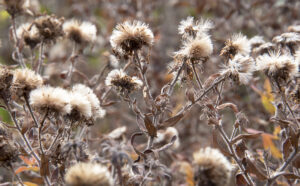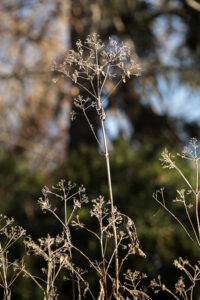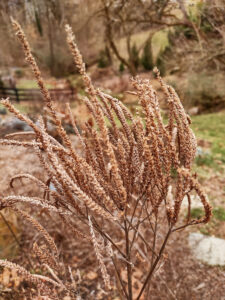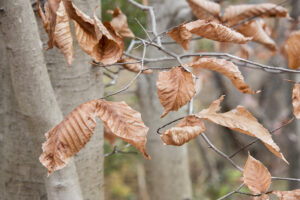The shortening days of fall signaled to our plants that it was quitting time for the food-making machinery in their leaves. Green chlorophyll faded away and allowed an array of other colors to emerge in our foliage, delighting the eyes as we brace for the even darker winter days ahead.
This annual transition may prompt the urge to “strip the sheets” in our ornamental garden beds. Cut dead stalks to the ground, rake away the leaves, cover it all with a thick layer of mulch, and let the garden rest tidily till spring. Out with the old as we await the fresh and new.
Don’t give in to this temptation! When we clear-cut ornamental gardens in the fall, we toss out much of what helps keep life going in the “dead” of winter—which isn’t dead at all. A lot is happening in the winter garden; it’s just a little harder to see.
Let Your Garden Fulfill Its Role in Nature
Most notably, the plants that provided food and shelter for birds and pollinators back in the summer continue to supply sustenance and nesting places for wildlife even in their dormancy. Many of our native bees nest in the hollow stems of grasses and other perennials. Butterflies attach their chrysalids to dry stalks and leaves. Caterpillars nestle in decaying foliage and seed pods. A host of beneficial critters overwinter in leaflitter.
Birds that spend the winter with us rely on these insects as food for themselves and their young while also feeding on the seeds and berries left on our seemingly lifeless perennials and shrubs. They also hide  from predators in the detritus of the winter garden. You can help the birds and your garden by blanketing the soil with up to three inches of fallen leaves, being careful not to smother delicate, low-growing plants or plants with a basal growth habit. To protect grassy areas, simply rake the leaves into your garden beds or around trees for a natural mulch. (For more on why we should “leave the leaves,” see this earlier Timely Topic.)
from predators in the detritus of the winter garden. You can help the birds and your garden by blanketing the soil with up to three inches of fallen leaves, being careful not to smother delicate, low-growing plants or plants with a basal growth habit. To protect grassy areas, simply rake the leaves into your garden beds or around trees for a natural mulch. (For more on why we should “leave the leaves,” see this earlier Timely Topic.)
Of course, in our vegetable gardens, removing spent plants is essential for preventing pests and diseases from coming back the next year. Even in the ornamental garden, you should dispose of any plants that show signs of disease. Otherwise, wait until spring for a thorough cleanup, just before new growth emerges—the forsythia blooming is your cue to start the process. Until then, let your garden do all it can to support nature.
Embrace Winter’s Chaos
Many of us may wince at the sight of the disheveled winter garden, as toppling stalks, faded flowers, chewed up seedheads and browning foliage crumble away. Plus, some HOAs may not allow it. If the ecological benefits aren’t enough to motivate you to embrace this messiness, then take some easy steps to enhance its visual appeal. With a little imagination and careful plant selection, you can continue to enjoy the look of your garden even in the bleakest season.
First, give some thought to perspective. Where do you see the garden most? From your kitchen window? From the living room? As you pull into the driveway? Your entire garden doesn’t have to shine, just the parts you are most likely to see, indoors or out.
As the sun sinks lower, think silhouettes. The skeletal structures of deciduous woody plants will stand out against the sky or against evergreens. Bristly seedheads will sparkle in early morning frost. Muted hues will become more vibrant in the slanted light. Also, position your plantings to reveal all the good things that are happening in the winter garden, such as finches feasting on spent coneflowers or white-throated sparrows kicking up leaves to find food.
Provide a Winter Haven for Wildlife
In any season, establishing layered arrangements of native plants will make your yard and garden a haven for birds, insects, and other wildlife. This is especially true in winter. Combining a lower layer of groundcovers, a middle layer of grasses and perennials, and a taller layer of shrubs and trees, layered landscapes mirror natural plant communities. They provide vital support for wild creatures and, with the right plant choices, a running banquet of shape, texture, color, and even sound during the winter months. (For more on planting in layers for habitat structure, see “Earth Day Starts at Home: Plant Layers for Habitat Structure,” a blog post by Carol Heiser on the Virginia Department of Wildlife Resources’ website.
Here are just a few examples of plants that will enrich your winter garden.
Herbaceous Plants
 Blue verbena, a.k.a. blue vervain (Verbena hastata), catches the eye with long-blooming candle-shaped panicles, which become golden seedheads (shown at right) that attract birds such as song sparrows and slate-colored juncos in wintertime. Likewise, cutleaf coneflower (Rudbeckia laciniata) will keep finches happy after blooms are gone, and late-flowering goldenrods (Solidago spp.) and asters (Symphyotrichum spp.) provide food for wildlife into February and March. The spent flowerheads of joe pye weed (Eutrochium spp.) hover as high crowns over the winter garden, while threadleaf bluestar (Amsonia hubrichtii), shown at top, holds onto its autumn glow well past the season.
Blue verbena, a.k.a. blue vervain (Verbena hastata), catches the eye with long-blooming candle-shaped panicles, which become golden seedheads (shown at right) that attract birds such as song sparrows and slate-colored juncos in wintertime. Likewise, cutleaf coneflower (Rudbeckia laciniata) will keep finches happy after blooms are gone, and late-flowering goldenrods (Solidago spp.) and asters (Symphyotrichum spp.) provide food for wildlife into February and March. The spent flowerheads of joe pye weed (Eutrochium spp.) hover as high crowns over the winter garden, while threadleaf bluestar (Amsonia hubrichtii), shown at top, holds onto its autumn glow well past the season.
Grasses
Native grasses provide shelter and nesting material for birds, larval hosts for various butterflies, and a palette of color and texture that can last well into winter. Big bluestem (Andropogon gerardii) and little bluestem (Schizachyrium scoparium) perform all these functions, as do prairie dropseed (Sporobolus heterolepis) and muhly grass (Muhlenbergia capillaris), at left, which are good options for smaller spaces.
Deciduous Shrubs
After their bright fall foliage drops away, witch hazels continue to reward us with late blooms. The Virginia native witch hazel (Hamamelis virginiana) flowers fragrantly from October to December, as seen at right. Ozark witch hazel (Hamamelis vernalis) blooms January to March. Both are go-to options for rain gardens. Fothergilla (Fothergilla gardenii), beloved for its fluffy spring flowers and fall color, earns its place in the winter garden with its interesting branch structure. The shade-tolerant Carolina allspice or sweetshrub (Calycanthus floridus) offers an abundance of four-season qualities, including tough, gnarled seed pods that cling to leafless branches.  The oakleaf hydrangea (Hydrangea quercifolia) adds texture as well as color to the winter scene, with attractive peeling bark and flower clusters that linger after fading to brown. With its signature red stems, the red-osier dogwood (Cornus sericea) is at its best in winter, especially in snow.
The oakleaf hydrangea (Hydrangea quercifolia) adds texture as well as color to the winter scene, with attractive peeling bark and flower clusters that linger after fading to brown. With its signature red stems, the red-osier dogwood (Cornus sericea) is at its best in winter, especially in snow.
The violet fruits that encircle the stems of American beautyberry (Callicarpa americana) will hang on to feed songbirds into the winter. Steer clear of Asian beautyberry species, which can become invasive. The bright berries on the deciduous winterberry holly (Ilex verticillata) will also add food and a pop of color to your winter landscape. Be sure to have at least one male plant to pollinate the berry-producing females. Check plant tags to identify compatible cultivars. For example, ‘Southern Gentleman’ pairs well with ‘Sparkleberry’ and ‘Winter Red’; ‘Mr. Poppins’ is a good match for ‘Berry Poppins.’
Evergreen Shrubs
Evergreen shrubs can serve as accents or backdrops in the garden’s winter structure. Evergreen hollies (Ilex) are especially effective. Like their winterberry cousin, they require both a male and a female to produce berry-like drupes for winter feeding. Yaupon holly (Ilex vomitoria), which hails from far southeastern Virginia, can be used to form a trimmed hedge or a less formal screen. Inkberry holly (Ilex glabra) has a lower profile.
Trees
The tree layer offers something for all senses in the winter tableau, including the rustle of dry leaves. Trees that hold onto foliage past fall (a property known as marcescence) include American beech (Fagus grandifolia), shown here, and many of our oaks. For interesting textures and color, look to the warm-toned peeling bark of the river birch (Betula nigra) and the catkins that dangle on the eastern hop-hornbeam (Ostrya virginiana). 
As you manage spaces under and around trees, adopt the concept of soft landings. The area from the trunk to the dripline is a transition zone not just for plants on the ground but also for the insects and other wildlife in the tree. After feeding on foliage during the growing season, butterfly and moth caterpillars spend the next stage of their lifecycle in the leaflitter or soil below the tree. Herbaceous plants under the tree provide food and shelter for these insects—a soft landing, as it were. Keeping fallen leaves around trees and letting plants stay in place into winter creates these soft landings.
Enjoy What You’ve Created
If you absolutely must cut back your garden, keep stalks as long as possible. Place them and other debris in a brush pile along a fence, behind a shed, or some other out-of-the way spot to give shelter to nesting insects and other wildlife during the cold months ahead.
But if you can, put off this task. Appreciate that your garden doesn’t need to be kept to the same standards of order as your house, and take fall cleanup off your chore list. Use the time to sit back, gaze out the window and take in the many but often subtle joys of the winter garden and its gifts to the natural world.
Prepared by Caroline Polk and Bill Sublette
Piedmont Master Gardeners
Resources
- Mary Free (2020). For the birds, butterflies & hummingbirds: Creating Inviting Habitats. VCE Pub. HORT-59P.
- Kate Holt and Emilee Morrison (2023). Reasons NOT to Clean Up Your Garden Before Winter. North Carolina Extension.
- Lisa Rittenhouse (2023). Winter sowing: Easy, productive, enjoyable. The Garden Shed, 9(11). Piedmont Master Gardeners.
- Scott Hoffman Black (2020). Leave the Leaves to Benefit Wildlife. Xerces Society.